
Birding Around Las Vegas
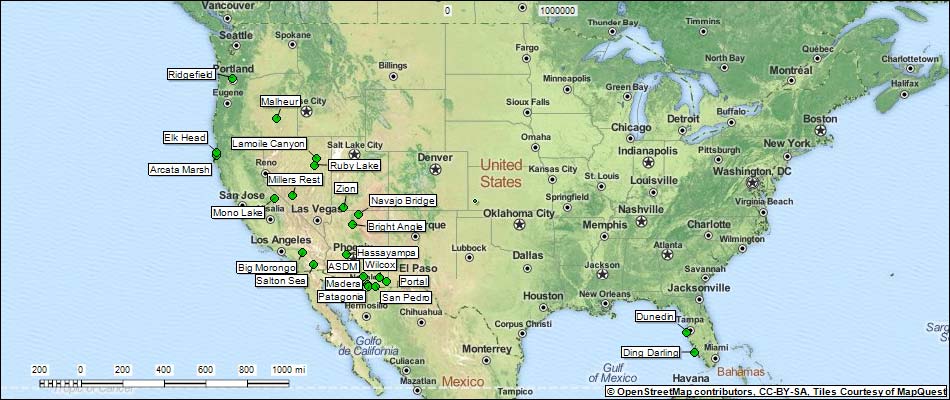
The places listed here are an eclectic collection of birding sites outside the Las Vegas area that, for one reason or another, I found to be particularly interesting. To some extent, these sites are a better reflection of my wanderings than a concerted effort to select the best sites. None of the descriptions here do justice to these extraordinary birding sites, but here I bring together a collection of sites, developed over three decades of birding, that should whet the appetite of birders and provide ideas on interesting places to visit.
This list of my favorite birding sites is sorted alphabetically by state, and then by my personal preference within states. For example, while they are all favorite places, I schedule vacations to visit Portal and Madera Canyon, and when I'm birding southern Arizona, I would stop at the San Pedro if I had time, but I wouldn't schedule a vacation to see it.
| Arizona | Arizona |
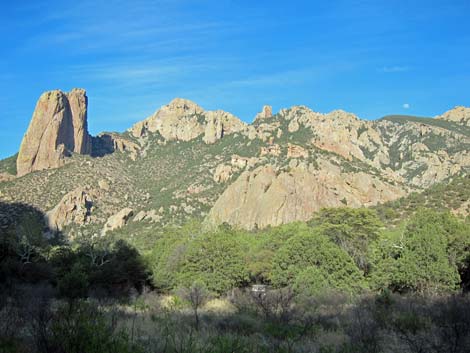 |
Chiricahua Mountains, Southeastern Arizona Mountains -- The islands-in-the-sky mountains of Southeastern Arizona are the only place in the U.S. to find a bit of high-elevation Mexican subtropical forest, and these mountains mark the northern limits of many species of Mexican birds. With Elf Owls in Portal, Coatimundi and Elegant Trogons in Cave Creek, Mexican Juncos and Red-faced Warblers in Rustler Park, and grand scenery in Chiricahua National Monument, there is nowhere else like this in the United States. |
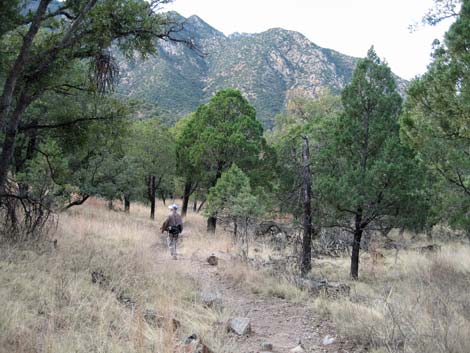 |
Madera Canyon, Southern Arizona Mountains -- The Santa Rita Mountains, an islands-in-the-sky mountain range in southern Arizona, rise steeply from desert valleys to high peaks covered in dense pine-oak forests. The change in elevation provides a variety of habitats, each with a different assemblage of birds. Madera Canyon harbors species such as Elegant Trogons, Mexican Jays, Hepatic Tanagers, and other species more typical of Mexico. |
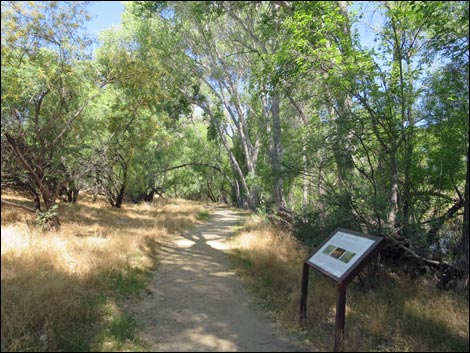 |
Hassayampa River Preserve, West-Central Arizona Riparian Corridor -- This area, protected by the Nature Conservancy and Maricopa County Parks and Recreation Department, is a great place to bird a riparian gallery forest during warmer months. Visitors can stroll trails through cottonwood forests, sit quietly on the edge of a lake, or just sit on the front porch and listen to birds singing in the trees while watching hummingbirds, orioles, thrashers, and woodpeckers coming in to feed. This area is particularly good for northern birders because this is the northern-most, easy to access, place to see species harder to find up north. For example, Gila Woodpeckers, Northern Cardinals, and Summer Tanagers are common here, but harder to find farther north. |
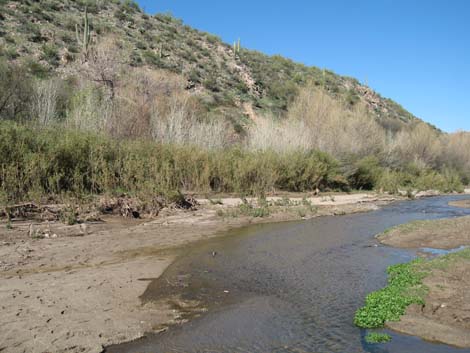 |
Hassayampa Roadside Rest Area, West-Central Arizona Riparian Corridor -- There are many riparian corridors in Arizona, but this is the only roadside rest area where I would stop and expect to see Vermilion Flycatchers in the parking lot. I always stop here, even if I'm in a hurry and don't need a rest. |
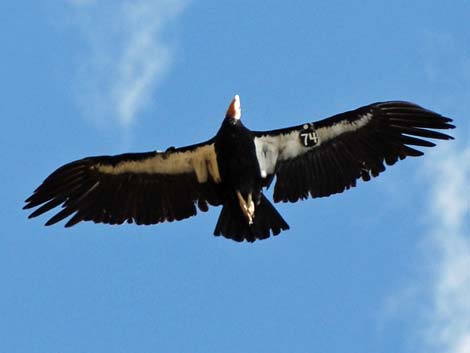 |
Bright Angel Lodge, Grand Canyon National Park -- Where else can you go to watch California Condors from an ice cream parlor while dangling your feet over a 4,600-foot cliff? |
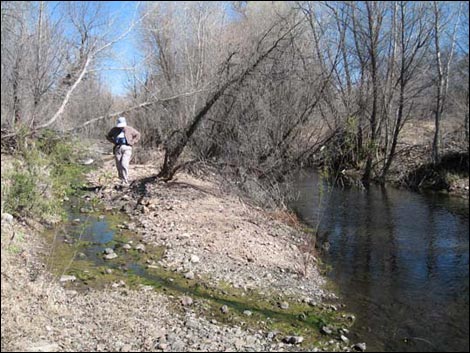 |
Patagonia, Southern Arizona Riparian -- The Patagonia area is a riparian valley where Sonoita Creek runs between the arid Patagonia and Santa Rita mountains in southern Arizona. The diversity of vegetation (riparian, desert, and mountain) provides habitat for many bird species, including Mexican species that reach the northern limit of their range in this area. More than 300 species of birds have been seen in the area. |
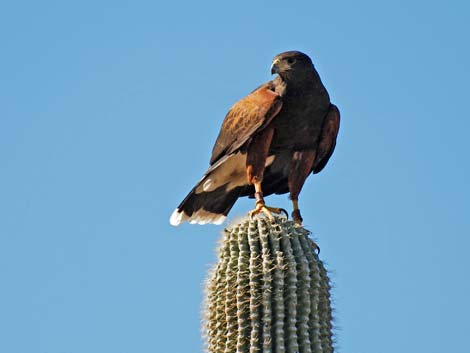 |
Arizona-Sonoran Desert Museum, Southern Arizona Desert -- This is a wonderful nature museum and zoo. The caged animals have realistic habitats that attract an amazing variety of wild birds. If you can't spot the wild birds, visit the aviary to get close-up with the species you've always searched for in the bush. I don't much care for zoos, but this is a wonderful place; and when I get there, I try to stay for a couple of days. |
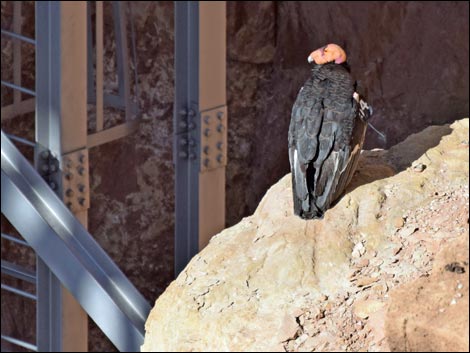 |
Marble Canyon, Navajo Bridge, Northern Arizona Red-rock Country-- In remote northern Arizona, Highway 89A runs through spectacular country with towering red-and-white sandstone cliffs on one side and a broad expanse of shrubland on the other. Hard to imagine from the highway, but the Marble Canyon section of the Grand Canyon lurks in the distance. Almost without warning, the land falls away as the road shoots off a cliff and onto the Navajo Bridge. The cliffs below the bridge are favorite hangouts for California Condor during winter. |
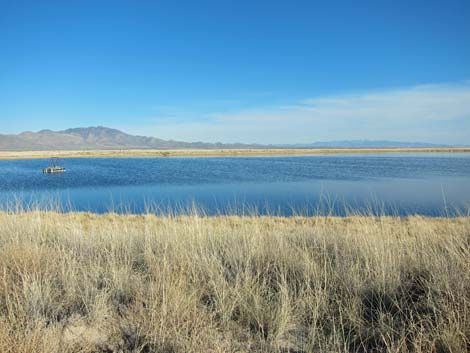 |
Wilcox Playa and the Cochise Lakes, Southeastern Arizona Wetlands -- Cochise Lakes, effluent ponds for the town of Wilcox, are located at the north edge of Willcox Playa in southeastern Arizona. The ponds, with depths ranging from shallow to deep, the adjacent golf course, and surrounding grasslands and seasonal wetlands provide habitat for a variety of migrant and wintering waterfowl, shorebirds, sparrows, and raptors. |
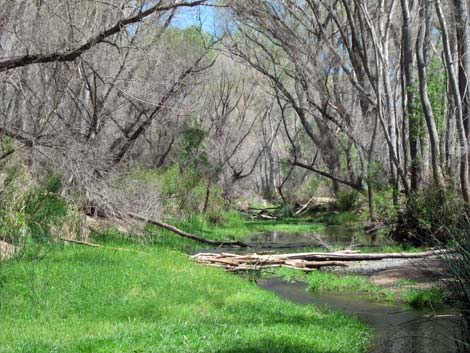 |
San Pedro Riparian National Conservation Area, Southern Arizona Riparian -- This riparian corridor runs north-south through the dry desert region north of the Mexican border, providing a well-vegetated corridor for breeding birds and migrants passing through on their annual journeys. Good birding for sparrows during winter. |
| California | California |
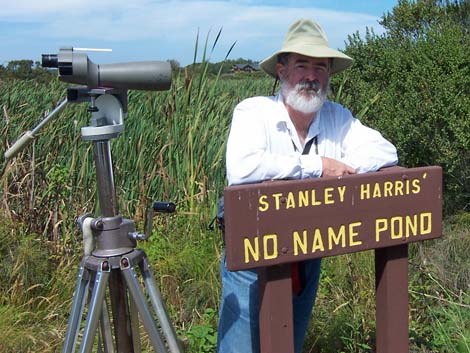 |
Arcata Marsh, Northern California Coast -- Humboldt Bay, with the twice-daily ebb and flow of the tide, presents an extensive mud flat where thousands of shorebirds and waterfowl stop over on migration or spend the winter. The Arcata Marsh and Sanctuary, a freshwater marsh located on the north end of the bay, is where many shorebirds go to rest during high tide when the mud flats are flooded; it is also the center of birding activity in the area. Liz and I learned Field Ornithology from Stanley "Doc" Harris. He is a great mentor, and it is just like him to not want a pond named after him. |
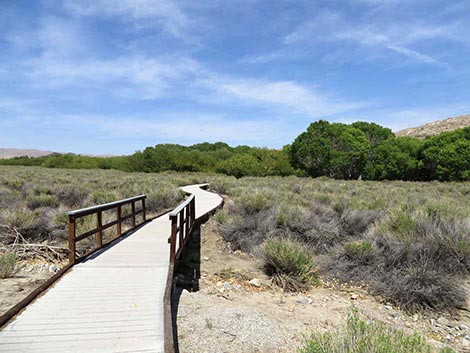 |
Big Morongo, Southern California Desert Riparian -- This riparian area in the desert mountains north of Palm Springs straddles the transition zone between the higher-elevation Mojave and lower-elevation Sonoran deserts. Well-vegetated areas amid arid desert slopes, plus open grassy fields in an adjacent community park, provide habitat for a remarkable density and variety of resident, migrant, and vagrant species of birds. |
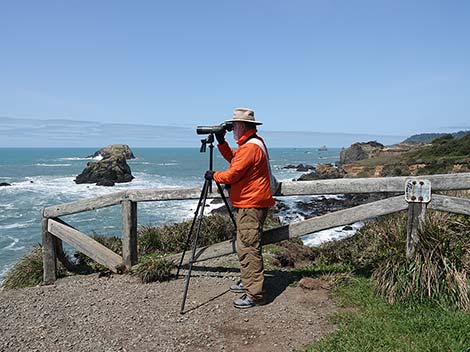 |
Elk Head, Northern California Coast -- While there are many headlands along the Pacific coast, this quiet place has always been special. This nice, quiet walk in the woods leads to a shrubby headland that overlooks the ocean and several off-shore islands where sea lions, harbor seals, and birds come to rest and nest. Look for nesting Tufted Puffins in the spring. |
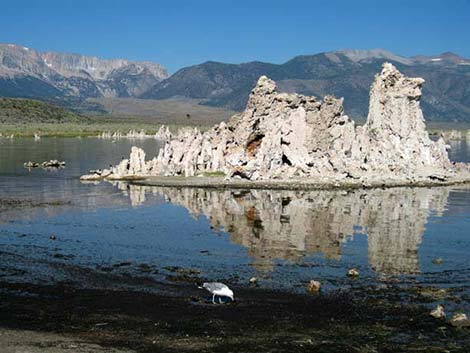 |
Mono Lake, Eastern California Brine Lake -- Perhaps known better for the tufa towers and western water wars, this salty lake provides habitat for billions of brine flies. The flies, in turn, provide food for many thousands of grebes, ducks, gulls, shorebirds, and other species. This is the place to see Wilson's and Red-necked Phalaropes during migration. |
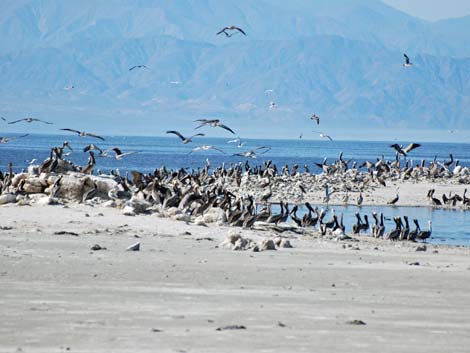 |
Salton Sea, Southern California Desert Lake -- Despite the filth and stench of the Salton Sea, this is a wonderful place to bird during winter. This body of salty water and the surrounding farm fields and trees attract huge numbers of water and terrestrial birds. I'll never forget birding there one evening when we saw waves of orange snow geese (lit up from the color of the sunset) flying back to the sea for the night. |
| Florida | Florida |
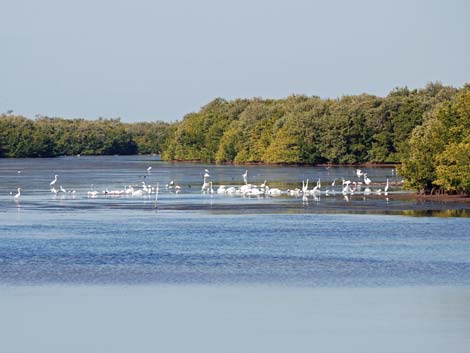 |
J.N. Ding Darling NWR, West Florida Mangrove Swamp. Located on Sanibel Island, a subtropical barrier island in the Gulf of Mexico, the refuge is part of the largest undeveloped mangrove ecosystem in the United States. Two impoundments (totaling 850 acres) are managed to provide foraging habitats for resident and migratory birds (also to control saltmarsh mosquitoes!). The refuge is world famous for the spectacular bird populations that include notable species such as Wood Stork and Roseate Spoonbill. An auto tour, several foot and bike trails, and two canoe trails provide close-up access to an amazing array of birds and other wildlife. |
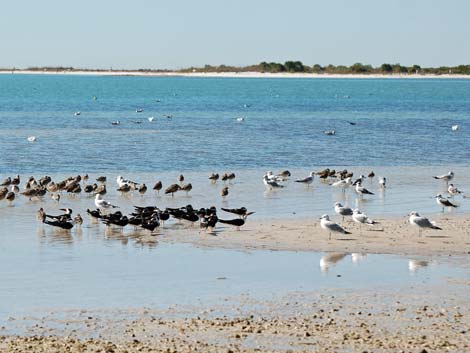 |
City of Dunedin, West Florida Beaches and Inland Woods. Dunedin is one of those places where Northerners go to escape the winter cold, and a lot of locals enjoy the year-round warm weather. Of course, I'm talking about birds. While the bird life is not as stunning as places farther south, the City of Dunedin is a great place to see birds, many of whom are habituated to humans and allow close approach. Dunedin has beaches, mangroves, pine-oak forests, and marinas, each with a special mix of birds. While not native, the feral parakeets provide an extra bit of excitement. |
| Nevada | Nevada |
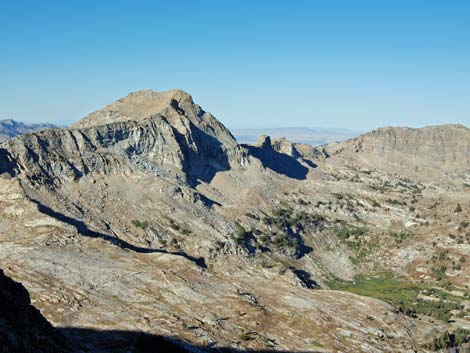 |
Lamoille Canyon, High Mountains in Northeast Nevada-- The Ruby Mountains in northeast Nevada provide high and rugged territory where Himalayan Snowcocks and Mountain Goats find refuge among steep cliffs. Scenic Lamoille Canyon provides access to the high country, but a stout hike awaits any birder searching for birds in the high country. |
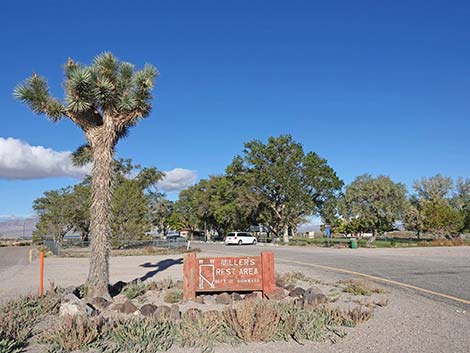 |
Millers Rest Area, Western Nevada Desert -- This is one of the most amazing birding sites in all of Nevada, but it is disguised as an ordinary roadside rest area with a lawn and trees that are heavily irrigated every night. Many places have been described as islands of green vegetation in a sea of dry desert scrub, but Millers defines what that means. For migrant birds flying across this inhospitable land, Millers must shine like a beacon on a dark and stormy night. |
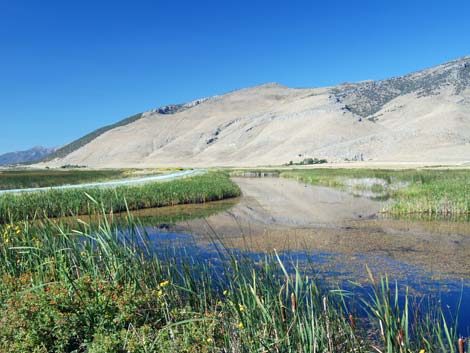 |
Ruby Lake National Wildlife Refuge, Northeastern Nevada Marshes -- Winter runoff from the mountains and water from springs combine to sustain wetlands in this broad, flat valley in northeast Nevada. Maintained roads through the marsh provide easy access to great birding in this quiet, out-of-the-way refuge. Bring your canoe and do some fishing too. |
| Oregon | Oregon |
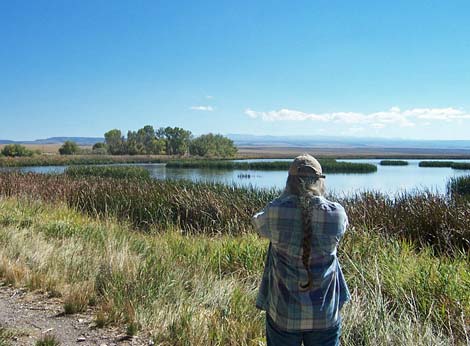 |
Malheur National Wildlife Refuge, Central Oregon Marshes -- Most of central Oregon is sagebrush desert or mountains, but the middle of the state is a broad basin. When it rains or snows on the mountains, water collects in this huge basin. The shallow marsh ponds and marshes provide habitat for a huge number of wintering birds, and the trees and shrubs at Malheur National Wildlife Refuge headquarters attract an amazing variety of migrants. |
| Utah | Utah |
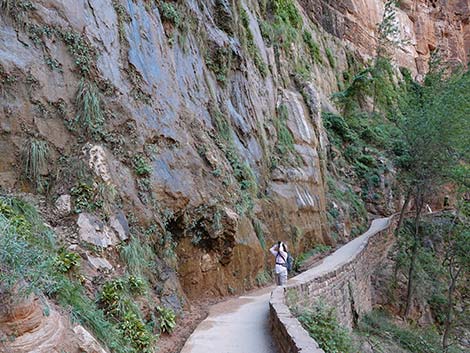 |
Zion Canyon, Southwestern Utah. Long known as a mecca for hikers and campers, is also a great place to bird during spring and summer, and the Riverside Walk is the best short hike in Zion and the best birding overall. This pleasant, paved trail starts at the end of the paved road in Zion Canyon and runs north along the Virgin River for about 1 mile. The trail starts where the canyon is fairly wide and ends when the canyon is too narrow for the trail. Most of the trail is fairly level, but there are a few steep parts towards the end. The trail is wheelchair accessible, but some parts would be hard to navigate without assistance or an electric motor. The trail ends at an overlook a few feet above the river where you can sit and relax or walk in the water and hike farther up the canyon. The views along this trail are spectacular. |
| Washington | Washington |
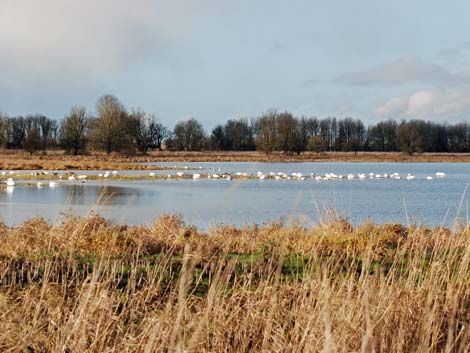 |
Ridgefield National Wildlife Refuge, Western Washington Freshwater Marshes -- This refuge sits in low country along the Columbia River, just down river from Portland, Oregon. Birding is good winter and summer, but for waterfowl, visit during winter. For birders, the "River 'S' Unit" of the refuge offers a loop road that circles a lake, follows creeks, and passes through open grasslands; plus there is a dry-season trail and a year-round observation blind. |
Happy birding! All distances, elevations, and other facts are approximate.
![]() ; Last updated 240322
; Last updated 240322
| Birding Around Las Vegas | Birds Around Las Vegas | Glossary | Copyright, Conditions, Disclaimer | Home |